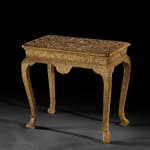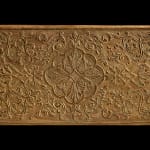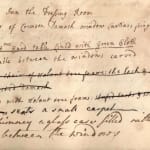
Fig. 1: The 1755 inventory of Ombersley by Richard Callowhill, where the present table is possibly recorded. Interestingly, when the document was heavily amended by Samuel’s daughter-in-law, Anna Maria, who dated her corrections 1st July 1775, the entry in respect of the ‘gilt table’ was left untouched, suggesting the table had remained in its position between the windows in the Dressing Room between 1755 and 1775, the period during which, coming after the end of his political career, Sandys spent most time at Ombersley.
A GEORGE I GILT-GESSO TABLE
Width: 29.75” / 77.5cm
D: 17.75” / 45.5cm
Further images
Provenance
Supplied to Samuel Sandys, 1st Baron Sandys (1695-1770) for Ombersley Court, Worcestershire, England
By descent with the Barons Sandys at Ombersley
DOCUMENTATION
Ombersley Court Inventory, 1755, in ‘Inn the Drefsing Room’, ‘a gilt table between the windows carved.’
Literature
Bowett, A., Early Georgian Furniture, 1715-1740 (Woodbridge, 2009), pp. 210-13
Beard, G. and Goodison, J., English Furniture 1500-1840 (London, 1987), p. 53, fig. 6
Edwards, R. and Jourdain, M., Georgian Cabinet-Makers, rev. ed.(London, 1955), p. 137, fig. 31
Oswald, Arthur, ‘Ombersley Court, Worcestershire – I-III’, Country Life, (January 1953)
The gilt-gesso furniture produced in the first decades of the 1700s was some of the most opulent of the century, made to occupy prime positions in magnificent rooms of parade and state and to enrich the sumptuous private apartments of royalty and nobility. The present table, jewel-like in its smaller scale, was made for a private room of Ombersley Court, the Dressing Room, adjacent to the Velvet Bedchamber, where it was possibly recorded in its pier between the windows in the 1755 inventory of the house (Fig.1).1
The quality of the table suggests the authorship of a leading maker. It bears close resemblance to another of c. 1720 - 26 at John Belchier’s most significant known commission, Erddig Hall, carved very similarly on the frieze with shells and acanthus leaves, and the possible connection is strengthened by the survival at Ombersley of a group of gesso mirrors that compares with the documented pier glasses supplied by him to Erddig in 1723 and 1726, the period when Ombersley was built and furnished.2
The nature of the flower-carvings on the earpieces of the present table, however, evokes the work of James Moore, perhaps the most renowned maker of furniture of this type, raising the possibility of his authorship. Indeed, Belchier’s bill for the gesso table at Erddig does not survive and so perhaps it was made by one of the other makers John Meller employed, namely John Pardoe and John Gumley, the latter of whom was Moore’s partner.
The table was made for Samuel Sandys, later Baron, a man so much the enemy of Sir Robert Walpole that on his retirement in 1742 the Frist Minister chose the name Orford for his title, ‘as an act of homage to one whose presence had cast a considerable shadow over the great prime minister’s political apprenticeship’.2 Horace Walpole noted: ‘Sandys is very angry at his taking the title of Orford, which belonged to his wife’s great-uncle. You know a step of that nature cost the great Lord Strafford his head, at the prosecution of a less bloody-minded man than Sandys’.3
Certainly, Sandys’ conduct over the course of his career earned him mixed reviews from contemporaries. He was probably the ‘person’ described by Lord Chesterfield as ‘without any merit but the lowest species of prostitution, enjoying a considerable post, got by betraying his own party’ and was famously identified by William Shippen as one of ‘those men with long cravats’ who ‘only desire places’.4 Following Walpole’s fall, he was made Chancellor by Pulteney, but ‘not equal to it, as is the general voice’, wrote Lord Egmont, he retired only 22 months later, although not before he had, wrote the new first lord Henry Pelham, ‘insisted on being a peer and cofferer’.4
Sandys was perhaps more popular in his seat of Worcester. Trusted and respected he received warm entreaties for help from the Clothiers’ Company. And a Worcester newspaper of 25th July 1733 suggests that he was loved locally: ‘Sam Sandys Esquire, one of our representatives, was met about two miles out of town by several hundreds of the principal inhabitants…from thence attended through the city with music, drums, streamers, and loud acclamations of joy’.5
With the Commons in session for less than six months in the year, there was plenty of time for other activities. Sandys was attentive to his estate, with surviving notes, even those about mundane matters, written in his own hand. As Martin Davis comments, ‘Samuel may have had something in common with the hated Walpole…who was said to open the Bailiff’s letters about the affairs of his estate before opening those dealing with affairs of state.’6
The table is made in the late baroque style, featuring French arabesque work boldly modelled in bas-relief, reflecting the ambition of its owner in richness, as did his Palladian house which he built with his wife’s £170,000 fortune. The cabriole legs were a new form at this time, a development of the pillar-leg popular during the reigns of William III and Queen Anne.7
1 Ombersley Inventory, 1755-75, in ‘The Drefsing Room’, ‘a gilt table between the windows, carved’
2 See National Trust, reference no. 1146957
3 D. W. Hayton, The History of Parliament (2002)
4 Martin Davis, Samuel 1st Baron Sandys of Ombersley, 1695–1770: Fragments of Nine Lives, No. 1, (2017), p. 13
5 Letters and Works of the Earl of Chesterfield, 1845–53, v. 233–4, see G. F. R. Barker, ‘Sandys, Samuel’, in Lee, Sidney (ed.), Dictionary of National Biography, Vol. 50. (Ldn., 1897)
6 Davis (2017), p. 14; Sedgwick, Romney R., ‘SANDYS, Samuel (1695-1770), of Ombersley, Worcs.’, in Sedgwick, R. (ed.), The History of Parliament: The House of Commons 1715-1754 (1970)
7 A. Bowett, Early Georgian Furniture 1715-1740 (Woodbridge, 2009), p. 210-3




